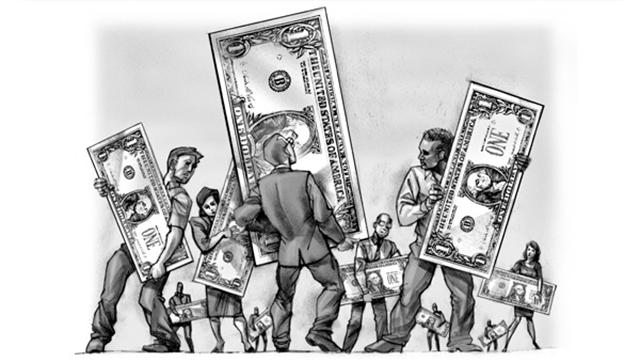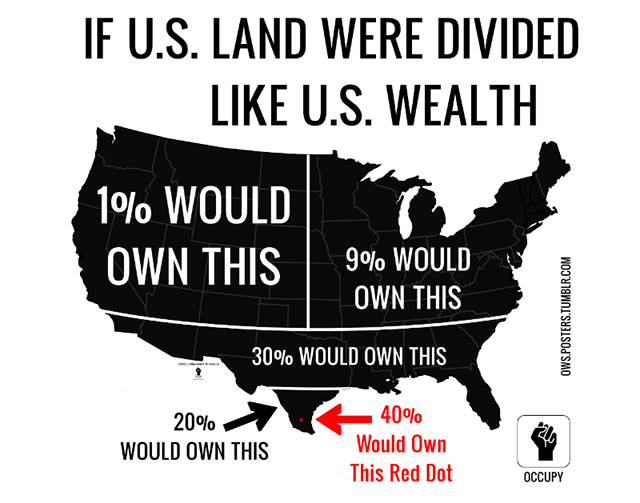
Headlines across the mainstream media lately have trumpeted the economy’s return. The sloganeering was almost deafening.
“U.S. household wealth regains pre-recession peak” roared the Associated Press earlier this month, and “Unemployment at 4-Year Low as U.S. Hiring Gains Steam” heralded The New York Times. Not to be outdone, The Wall Street Journal touted “Dow Leaps to Record.” The strength of emotion behind these self-congratulatory news features would lead you to think that the economy was set to boom.
The problem is that neither the stock market’s surge, nor a one month’s bump in hiring, nor a further concentration of wealth amongst America’s economic elite actually means very much to the rest of us.
The truth is that over the past 30 years there’s been a divergence in economic interests between a small number at the top and everybody else. We’ve come to dwell in two different economic universes. And the real economy—the one in which you and I live—is anemic at best.
So if the media’s self-proclaimed good times haven’t shown up on your doorstep, here are some reasons why.
1.Washington is a mess. In recessions governments are supposed to spend, because the private sector can’t. But Washington is doing the exact opposite and it’s undermining any chance of a sustainable recovery.
In fact, if Washington had invested money just to save government jobs in education and public safety—and repair the nation’s roads and bridges—we’d be creating almost twice as many jobs and growing at double the rate than we are right now. The economy would be a full tilt.
But the political class has talked itself out of a hundred years of economic fact—that government spending is positive in downtimes—and we can’t move as a result. In fact we’re losing. Close to a million jobs are forecast to be lost this year due to more budget cuts, and more family budgets will be squeezed.
2.Black and brown unemployment is off the charts. One out of three people in the United States is black or Latino. With double-digit unemployment in these communities, a huge swath of the country is experiencing Depression-like conditions. As people of color are the emerging majority, the long-term consequence of this severe economic distress is frightening. It’s already showing up.
Close to one out of three black people, and one out of four Latinos, lives in poverty. In fact, poverty is stuck at the highest level it’s reached in almost two decades, and black and Latino wealth is the lowest ever recorded.
Until the economic health of black and brown America is restored, given the growing weight of these two communities, there’s no way that the overall economy can get back on track.
3.We have a wage crisis. Excluding the highest income earners, wages for average Americans are at a 40 year low and they’ve been accelerating downward for three decades. This is a growing disaster because our economy is consumer led. Over 70 percent of economic activity in the U.S. is driven by the purchases that everyday people make. As wages slide downward, economic growth follows. That’s exactly what’s been happening.
In fact, as veteran journalist Hederick Smith, author of “Who Stole the American Dream?”, points out, wages are growing at a rate that’s 20 times slower than that of corporate profits. Globalization combined with America’s tax policies have caused corporate earnings to be larger than ever. And as a result wealth is piling up in the wrong place. Why? Because consumers are the ones who spend, not companies.
Even as their workers struggle to make ends meet, corporations are sitting on $2 trillion in unspent profits and our economy remains in suspended animation as a result.
4.Longterm unemployment is getting worse. More than 4 million people have been without work for six months or more. Disturbingly, their numbers are growing—up by 89,000 last month—and they’re unemployed for longer periods of time, at an average of eight months.
What’s more is that frustration with the lack of work has led many people to drop out of the workforce altogether. Labor force participation is at its lowest level in three decades. Without work, many people turn to the informal economy to support themselves. The off-the-books economy in the U.S. is huge, close $1.5 trillion, or equivalent to one out of 10 dollars in overall annual economic output. The problem is that informal work comes without minimum wage, worker protections and anti-discrimination rules, and it can thus further depress wages for everyone and place additional downward momentum on the economy.
5.International uncertainty is also worsening. America’s largest trading partner, the European Union, is mired in a double-dip recession and more than one out of 10 Europeans is without work. The economy of Greece, which grabbed headlines last year, has virtually disintegrated in the last 12 months.
What’s going on Europe is not only hampering our recovery, but is also a cautionary tale for the United States. Countries across that continent implemented government budget cuts before their economies had returned to full strength. As a result, the European economy has tanked and Europeans are worse off than a year ago. Should we fail to learn from the E.U.’s error we could repeat their mistake here.
With the right policies, all of these issues can be turned around or substantially mitigated. But we can’t do that unless we stop the unwarranted economic cheerleading, which only serves as a distraction and obscures our ability to see events clearly. We remain in uncertain times and what we need is frank talk and a sense of the bigger view. Given what’s at stake, each of us needs to insist on getting it.
Income Growth For Bottom 90 Percent Of Americans Averaged Just $59 Over 4 Decades
Another day, another mind-blowing fact about the staggering difference between the haves and the have-nots.
Incomes for the bottom 90 percent of Americans only grew by $59 on average between 1966 and 2011 (when you adjust those incomes for inflation), according to an analysis by Pulitzer Prize-winning journalist David Cay Johnston for Tax Analysts. During the same period, the average income for the top 10 percent of Americans rose by $116,071, Johnston found.
To put that into perspective: if you say the $59 boost is equivalent to one inch, then the incomes of the top 10 percent of Americans rose by 168 feet, Johnston explained to Alternet last week.
Johnston’s long-distance analogy is one way to look at the huge gap between the rich and everyone else, and there are many ways to think about and compare income growth and inequality across various segments of the population. Incomes for the bottom fifth of Americans, for instance, grew about 20 percent between 1979 and 2007, according to a 2011 study from the Congressional Budget Office. During the same period, members of the top 1 percent saw their incomes grow by 275 percent.
Another way to illustrate the huge disparity: the six heirs to the Walmart fortune had a net worth equivalent to the bottom 41.5 percent of Americans combined in 2010, according to an analysis from Josh Bivens at the Economic Policy Institute.
While income inequality may be great for those reaping the big bucks at the top, it’s likely hurting Americans overall. Greater income equality is correlated with stronger economic growth, according to a 2011 IMF report.
David Cay Johnston, Tax Analysts
3 WAYS TO SHOW YOUR SUPPORT
- Log in to post comments












